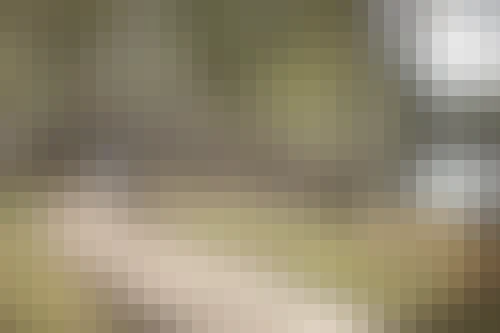Mungo National Park. Image credit: Murray Regional Tourism
Whether you’re a fan of venturing off-grid, or you’ve been toying with the idea of exploring a little further off the beaten track, Mungo National Park is one for your list.
Forming part of the Willandra Lakes Region, Mungo National Park is UNESCO World Heritage-listed for good reason – with ancient burial sites, fireplaces, stone tools and preserved footprints, this national park provides a window into Australia’s indigenous heritage.
It’s not just its rich history that has this national park listed high on everyone’s bucket list, it’s the landscape that more closely resembles the surface of the moon than something here on earth that draws people in.
If you’ve ever dreamt of voyaging on your own space mission, now’s your chance to let your imagination run wild.
To help you, we’ve pulled together everything you need to know when it comes to exploring Mungo National Park.
You’ll find Mungo National Park on the New South Wales side of the Murray River in the Wentworth region.
It’ll take you roughly an hour and a half to drive there from Mildura, across 20km of sealed and 88kms of unsealed dirt roads passing through the dry and dusty outback.
At first glance of Mungo National Park, you’d be forgiven for thinking you’ve somehow travelled through space and landed on a Mars-like terrain with its dry, red craters.
The Park’s ancient landscape of towering quartz and clay dunes, rugged sand formations, and dried-up lake bed is rich in lunar-esque natural beauty.
The discovery of the remains of Mungo Lady and Mungo Man preserved in the sand by carbonite and low humidity are some of the oldest remains of modern humans on the planet.
The unearthing of their remains alone rendered the park one of the most significant archaeological sites in the country and that’s before you discover any of the other artefacts that have been uncovered, dating back over 40,000 years including 20,000-year-old footprints of the Willandra people.
While it’s been years since water last filled the dry lake basins, the rain has eroded a mosaic of grey and red clay mounds. The dried soil of the ancient lakes is flanked with lunettes, a dune-like formation created by a build-up of sand and clay.
To the east of the lake, you’ll find cascading red dune fields and sand plains fringed with saltbush and other native shrubs and trees such as acacia.
All kinds of Aussie land and sky dwelling animals call the lunar-like landscape of Mungo National Park home.
You’ll likely spot a mob of emus prancing by, kangaroos enjoying some bush tucker, an echidna scurrying along as well as the mallee ring-neck parrot and wedge-tailed eagle, known to frequent the area.
A great way to get the lay of the land is to take the Mungo-self guided drive tour also known as the Mungo Loop Track.
This 70km loop guides you through the park’s desert landscape, pinpointing the best spots to jump out of the car and explore by foot.
The Red Top Lookout, Rosewood picnic area, Zanci Homestead and Walls of China are all great places to stretch your legs.
Be sure to allow at least two hours to navigate your way through, stopping to take in the sites and historical significance of each area.
You can collect a map and informational brochures from the Mungo Visitor Centre to help identify the best travel route.
Book an Aboriginal Discovery Tour for an informative deep dive into the stories and significance of the area while walking your way through the ridged, thick sand and clay formations.
If you really want to fall in love with the land make your way to the Walls of China Lookout for sunset as you watch the sun dip below the horizon, setting the dunes alight with a golden-hued glow.
If you’re wanting to pitch a tent and camp out for the night under the stars there’s two campgrounds within the park to choose from.
The main camp is just a few kilometres from the Visitor Centre with access to toilets and hot showers. The campground itself has free gas bbq's, fireplaces (BYO firewood), picnic tables and non-flush toilets.
If you’re looking for a more secluded spot, Belah Camp is a little more remote with picnic tables and non-flush toilets.
Book a bunk for the night at the Mungo Shearers Quarter in the heart of Mungo National Park. Up to 27 people can stay at any one time within the five rooms and make use of the communal kitchen, BBQ and showers (keep in mind you’ll need to bring your own bedding).
For something a little more luxurious, Mungo Lodge is just outside the national park, where a deluxe or self-contained cabin can be booked.
If you’re only planning on passing through Mungo National Park, there’s plenty of places to stay in Mildura.
We’ve pulled together a couple of housekeeping tips to keep you safe on the road and during your trip.
First of all, Mungo National Park is in off-grid, outback territory, meaning you’ll need to plan where to stop for fuel, water and food ahead of time, with the closest town, Pooncarie, 81 km away.
There’s also very limited (and at times no) mobile reception within the park so make sure you either pick up a couple of maps from the visitor centre, download satellite navigation or scrub up on your compass skills of finding true north.
Remember, flying drones in Mungo National Park is a no go unless you receive a written agreement from the Park Office before your visit.

Convoy through national parks for a week-long trek, curb a sneaky mid-weeker, or day trip into the…

Flanking the banks of Australia’s longest river, The Murray is best enjoyed once you step outdoors.